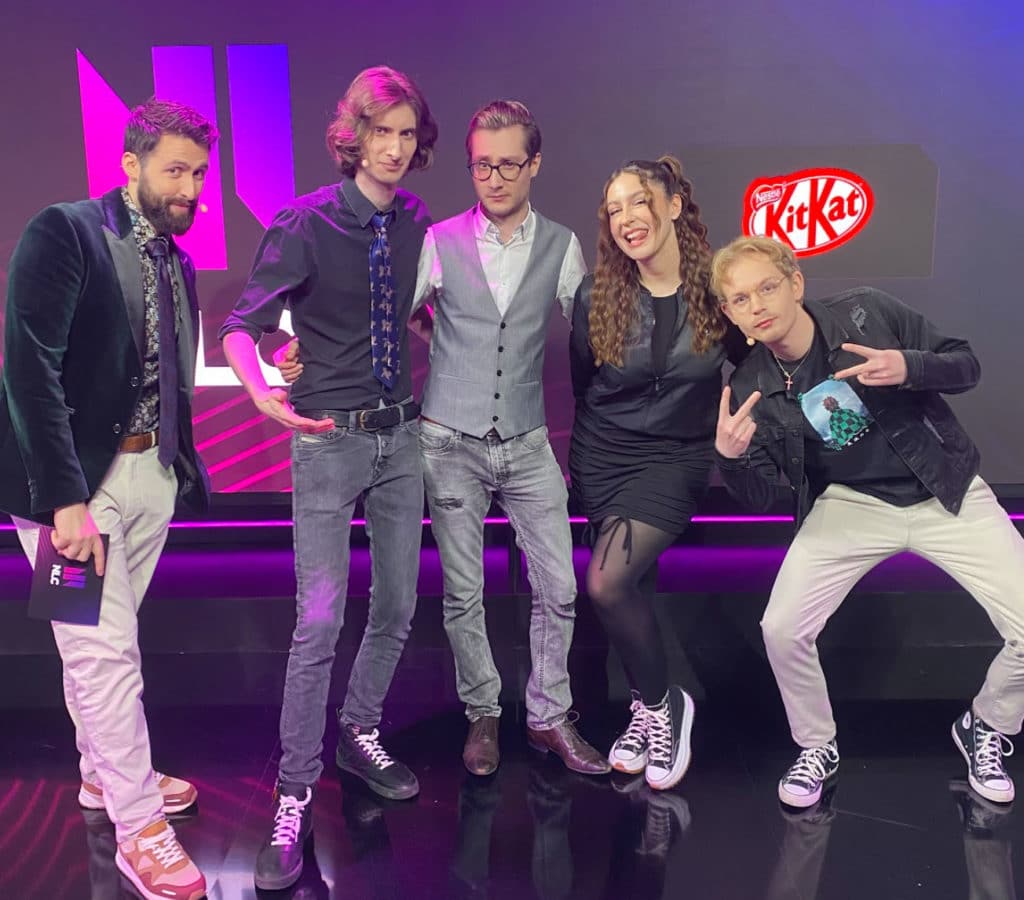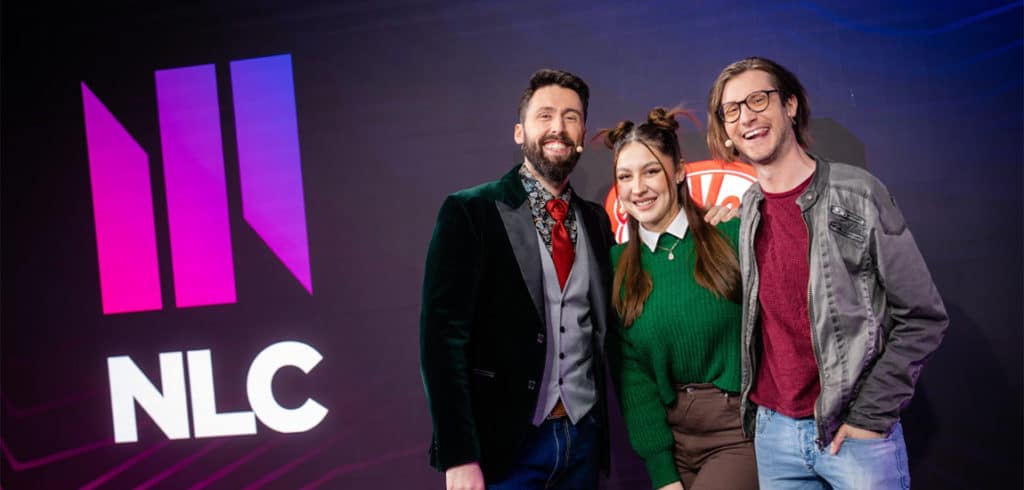Left to right: Broadcast talent Archarom, Trouble and Initialise (Image source: NLC, Spring 2022)
It’s official – roughly a year and a half after disbanding the National League system across the NLC in favour of a combined set of divisions, the structural changes are being largely reverted. That’s right – the LoL National Leagues are back and all the masses rejoiced. Or something like that, at least, writes caster Sam ‘Initialise’ Hapgood in this opinion piece.
A quick primer on the history for those not in the know: back in 2020, the Northern League Championship, aka the NLC, was created by merging two previously separate regions in the UKLC and Nordic Championship. With that new conglomerate region came a sprawling format that included a 12-team Division 1 (with split groups), six parallel Tier 2 National Leagues, the Telia Masters promotion tournament, the NLC Relegation Tournament… and all of that isn’t including Tier 3 leagues like the UKEL.
If that sounds complex, that’s because it was. It was labyrinthine and opaque, a frankensteinian mishmash of systems and formats born from the merging of two regions into one. Now, to be clear, I highly enjoyed the old system. It had a thriving grassroots scene with distinct national identities and a strong Division 1 that consistently put up fierce performances at EU Masters, and for all it was convoluted it was born out of a lot of passion and was at the very least interesting. That is not to say it didn’t have its issues – some of which are self-evident here.
It was a wild ride, to say the least.
Then came the great changing of the guard in 2022. Freaks4U took over NLC production from Dreamhack towards the end of 2021, and began instituting huge reforms and restructuring the region in preparation for the 2022 season. They did so by rebuilding the NLC in the image of the Prime League, a league Freaks also ran. Goodbye fractured National Leagues, hello streamlined linear divisions.

In theory, it was supposed to be a fresh new start. A broadcast run with live from studio, by a company that helped produce LEC, VCT and Prime League and also had a damn good talent team (allow me a little self indulgence – but seriously, all of the main team ended up at minimum appearing on EU Masters, the majority on LEC or LPL).
Add in a more defined league structure, and a new golden age was upon us, right? And while I remain proud of the show we as talent put on last year for the NLC Div 1, for all that it wasn’t smooth sailing, the quality of the Division 1 did not cover for the failings in lower divisions. And that is definitely more prescient to this article.
Namely, what ended up happening was the withering of the grassroots scene.
The Death of a Garden
Let’s take a case study in the UKEL, the National League for the UK and Ireland below the UKLC. In other words, about as grassroots as it came in within the NLC ecosystem. With the tectonic shakeup in the ecosystem, the UKEL was suddenly bereft of a position under new management and when the league announced it could not run, many of the organisations, players and broadcast staff and talent were left adrift. And that included that oh-so critical part of the grassroots scene – the community.
Anyone who’s ever participated or worked in grassroots can tell you the fans, family, friends and rivals are what sustains the entry level scene. They provide the interaction, the energy and often the graft required to keep things afloat – many of the roles at that level are often volunteer positions, and the people who have the passion and inclination to take on those responsibilities are nearly invariably drawn from the community.
“Anyone who’s ever participated or worked in grassroots can tell you the fans, family, friends and rivals are what sustains the entry level scene.”
Now, I am aware I come in with certain biases and experiences – I make no secret of that. One of the first leagues I ever cast was the UKEL alongside Nymaera, my brother, and it was also the league where a fair amount of my work got me noticed for bigger gigs. I have fond memories of X7 slamming in a Gwen jungle on her release and Synapse’s Nocturne top, of screaming my head off at Lucent’s mad climb to the UKLC.
I was sad to see the league close down, even if I had some hope that a new structure might bring in a more codified and less convoluted system than the labyrinthine behemoth that was the marriage of Telia Masters, National Leagues, the NLC itself and of course participation in EU Masters (now EMEA Masters).
On paper, there were potential upsides to the restructure – a unified system that combined all the regions under the NLC banner (as opposed to fractured National Leagues), under the auspices of a Riot-backed system run by a tournament organiser who had a successful track record with Prime League. It promised big things: more reliable tournament admins, clear means of progression, consistent rulings, room to increase scale with ever wider and deeper divisions.
It also failed to account for what the NLC actually is.
At its core, the NLC is a melting pot of nominally quite disparate regions, all of which have strong national identities, communities and cultures. This makes the NLC incredibly different in its makeup to many other ERLs. It is not like the LVP, LFL or Prime League which have much more singular cultures and fanbases. The NLC doesn’t even strictly have a unifying language! For the majority of the participating countries, English is a second language and, even within the UK, the likes of Welsh, Gaelic and Irish are all proudly spoken and practised as mother tongues.
But by trying to homogenise the NLC through collapsing the National Leagues into a streamlined format, the baby was somewhat thrown out with the bath water. Yes, a more cohesive identity for the NLC as a region is something to continue working on, but to do so at the expense of arguably its defining trait – namely, the strong national identities – feels like inverting the problem, rather than solving it.
In fact, in a recent interview with UKEL on this website discussing the return of the tournament organiser, a founder of the UKEL, Alex ‘Synygy’ Winton, characterised the issue well. He agreed that ‘absolutely’ the changes to the NLC had led to a loss in national identity within the league, even though he did note that Freaks’ ‘reasons for doing so were valid when looking at the NLC region as a whole.’
“… by trying to homogenise the NLC through collapsing the National Leagues into a streamlined format, the baby was somewhat thrown out with the bath water.”
More concretely, the UKEL’s Synygyy singled out two things I feel are especially pertinent to why reinstating National Leagues in some capacity is a necessity: one, it revitalises local communities. Yes, we live and socialise in an increasingly online capacity, and that’s ever more true when it comes to games like League. Yes, the NLC aims to foster a more interconnected community within its various subsidiaries. Those are valuable things. But – and I cannot stress this enough – that will never truly be a replacement for actual local communities.
Your friends, your culture… hell, your sense of humour – those are all innately tied to a person’s sense of not just identity but belonging too. Fostering that within the NLC, namely where it already exists at a local, national level, is paramount to a grassroots scene. You cannot brute force that inorganically by attempting to transplant those communities out of the spaces that created them, especially when it was done so recalcitrantly at best by said communities.
“Without a local community it’s hard for any recreational activity to thrive, whether that’s sports, hobby clubs, or esports, because you lack that sense of belonging.”
Alex ‘Synygy’ Winton
The addendum (and second point) is that local communities also provide easier access to the scene. Local communities are generally a lot more approachable by interested parties, and they also have better reach and access to their targeted demographics. Case in point, the tweet below is a direct example of grassroots outreach.
Arcurath, former UKEL support player and coach, is in the process of building a team for the upcoming UKEL 4 Nations tournament – a task made a lot easier when the connections and community links are already present to reach out through.
For all this, I do still wonder what would have happened if Freaks’ changes had been introduced with less blunt force trauma. There is some truth to the fact that because Freaks4U took over the NLC on short notice from Dreamhack, plans to reformat the region were always going to be done on a tight timetable. And that, as much as the scale of the plans themselves, was always going to send huge shockwaves across the ecosystem. Teams and talent that had planned their off-seasons around Dreamhack’s system were suddenly scrambling around new qualifiers and structures on around two months’ notice.
Perhaps if the changes had been executed with a year’s notice – not a few weeks – the outcome may have been different, or at least less extreme. In the end that’s immaterial. What we got was oil on a fire that was already consuming the grassroots scene, instead of connecting the separate grassroots scenes together to make a greater whole as planned.
- Read More: NLC 2023 Summer Playoffs Teams Confirmed
Even so, a revival of national, and thereby local, scenes is a hugely welcome step forwards. It’s not quite the original system; there is a continuation of NLC Division 2, which should help make the gulf between NLC proper and the National Leagues less vast (and therefore more bridgeable by teams attempting to promote from the National Leagues).
There’s also the wildcard addition of the NLC Ladder which could either be what Champions Queue was supposed to be and an amazing gateway for otherwise teamless players to get into the NLC system, or its less formal structure and a failure to retain engagement could see its potential squandered. Time will tell.
Where Does the NLC Go From Here?
A replanting of the grassroots scene matters, and it’s a necessary step. It is not, however, a cure-all for the NLC.
Make no mistake: there are still issues the region needs to resolve: courting sponsors that are interested in the odd combination of countries within the NLC (most sponsors will either be interested in individual countries or the entirety of Europe, not the unusual conglomeration here), converting the disparate national identities into an NLC identity, enticing English speaking viewers to the region when facing competition from all the Tier 1 broadcasts that are also in English…
There’s also the lingering effects of the elephant in the room: the back-breaker that was moving the NLC from accredited to non-accredited ERL at the end of last year. That hurt every division, but especially the upper end of the region’s play.
Cultivating a thriving and engaged grassroots system helps, but it’s a longer term project. Talent will need time to filter up, any growth will need time to see dividends. But if the NLC is to build towards accredited ERL status once more – or at least become a stable league that isn’t constantly losing teams – the foundations have to be there.
And that for me will be the test of whether these changes are what I hope they will be. Fingers crossed – gardening gloves on.
Thanks to Initialise for writing this guest opinion piece. You can follow Initialise on Twitter here
Essential UK Casino & Betting Guides
Looking for the best casinos or betting sites? Below you’ll find our recommended guides that players in the UK are loving right now.


